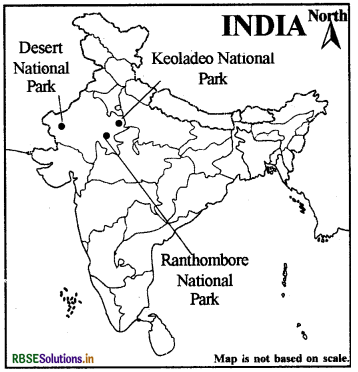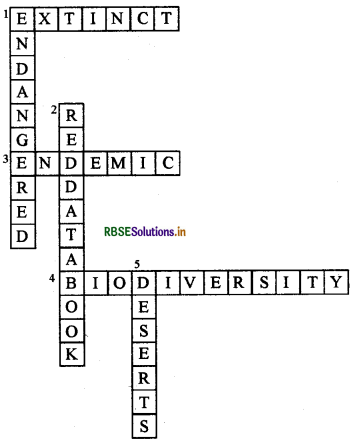RBSE Solutions for Class 8 Science Chapter 7 Conservation of Plants and Animals
Rajasthan Board RBSE Solutions for Class 8 Science Chapter 7 Conservation of Plants and Animals Textbook Exercise Questions and Answers.
Rajasthan Board RBSE Solutions for Class 8 Science in Hindi Medium & English Medium are part of RBSE Solutions for Class 8. Students can also read RBSE Class 8 Science Important Questions for exam preparation. Students can also go through RBSE Class 8 Science Notes to understand and remember the concepts easily. Browsing through class 8 science chapter 14 extra questions that includes all questions presented in the textbook.
RBSE Class 8 Science Solutions Chapter 7 Conservation of Plants and Animals
RBSE Class 8 Science Conservation of Plants and Animals InText Questions and Answers
Page 77
Question 1.
What is the purpose of making national parks, wildlife sanctuaries ant biosphere reserves?
Answer:
The objectives of formation of national parks, wildlife sanctuaries and biosphere reserves are to provide protection and conservation areas, to plants and animals.

Question 2.
How does deforestation reduce rainfall on the one hand and lead to floods on the other?
Answer:
Deforestation increases the temperature level and pollution level on the Earth by increasing die level of carbon dioxide in the atmosphere. The increase in temperature on Earth disturbs the water cycle resulting in reduced rainfall.
On the other hand deforestation decreases the water holding capacity of the soil due to which the movement of water from the soil to the ground reduces resulting in floods.
Page 81
Question 3.
I have heard that some of the endemic species may vanish. Is it true?
Answer:
Yes, it is true. The destruction of their habitat, increasing population and introduction of new species may affect the natural habitat of endemic species and endanger their existence.
Page 82
Question 4.
What is the difference between a zoo and a wildlife sanctuary?
Answer:
Zoo: is such a place where animals are protected in their own natural habitat. Here food is provided to animals.

Page 83
Question 5.
Are only big animals facing extinction?
Answer:
No, small animals are much more in danger of becoming extinct than the bigger animals.
Page 84
Question 6.
What would happen if we had no wood? Is there any alternative available to wood?
Answer:
If there is no wood means there is no tree. Trees are essential for maintaining physical world and for the survival of all human beings. No trees means no life. Secondly, if we talk about the products made by wood we can use the alternative available for wood that are plastic, fibre material, glasses, etc.
Question 7.
Is there any permanent solution to the problem of deforestation?
Answer:
Yes, the permanent solution to the problem of deforestation is reforestation. We should plant more and more new trees as we cut.
RBSE Class 8 Science Conservation of Plants and Animals Textbook Questions and Answers
Question 1.
Fill in the blanks:
(a) A place where animals are protected in their natural habitat is called ......................
(b) Species found only in a particular area is known as ......................
(c) Migratory birds fly too far away places because of ...................... changes.
Answer:
(a) wildlife sanctuary
(b) Endemic species
(c) climatic.
Question 2.
Differentiate between the following:
(a) Wildlife sanctuary and biosphere reserve
(b) Zoo and wildlife sanctuary
(c) Endangered and extinct species
(d) Flora and fauna
Answer:
(a) Wildlife sanctuary: is an area which provides protection and conservation to wild animals.
Biosphere reserve: is a large area of protected land for conservation of wildlife, plants and animal resources and traditional life of the living in the area.
(b) Zoo: is such a place where animals are protected in their own natural habitat. Here food is provided to animals.
Wildlife sanctuary: is an area where animals and their habitat are protected without any disturbance. Here animals get self poaching (hunting) and get food.
(c) Endangered species: The species which are facing danger of extinction. Example: Bengal tiger, Blue whale, etc.
Extinct species: The species that no longer exists on Earth. Example: Great auk, passenger pigeon.
(d) The plants found in a particular area is the flora of that area and the animals found in a particular area is the fauna of that area.

Question 3.
Discuss the effects of deforestation on the following:
(a) Wild animals
(b) Environment
(c) Villages (Rural areas)
(d) Cities (Urban areas)
(e) Earth
(f) The next generation
Answer:
(a) Effect on wild animals:
Plants provide habitat and food to wild animals. If natural habitat is destroyed, animals will become the endangered species.
(b) Effect on environment:
Due to deforestation there is decrease of oxygen in atmosphere. Plants need carbon dioxide for photosynthesis. Fewer trees would mean that less carbon dioxide will be used up resulting in its increased amount in the atmosphere.
This will lead to global warming as carbon dioxide traps the heat rays reflected by the earth. The increase of temperature on the earth disturbs the water cycle and may reduce rainfall. It may cause droughts.
(c) Effect on Villages (rural areas):
Most of the agriculture is done in rural areas. Fewer trees result in more soil erosion. Removal of the top layer of the soil exposes the lower, hard and rocky layers. The soil has less humus and less fertile.
(d) Effect on cities (urban areas):
In cities industries and vehicles are used more in number. Deforestation causes pollution and citizens will not be healthy.
(e) Effect on earth:
Fewer trees on the earth result into soil erosion. Due to this there is decrease of humus in soil. Gradually the fertile land converts into desert. Deforestation also leads to a decrease in the water holding capacity of the soil.
The movement of water from the soil surface into ground (infiltration rate) is reduced. So, there are floods. The other properties of the soil like nutrient content, texture etc. also change because of deforestation.
(f) Effect on the next generation:
Rare plants and animal species are also damaged by deforestation and the next generation can see them only by means of diagrams (pictures). Next generation will struggle due to decreased resources.

Question 4.
What will happen if :
(a) we go on cutting trees.
(b) the habitat of an animal is disturbed.
(c) the top layer of soil is exposed.
Answer:
(a) If we go on cutting trees, rainfall in that area will decrease. There will be more chances of floods. In that area ground water level gets lower, it decreases the humidity in the air. Pollution may increase. Wild animals and plants will perish. Global warming increases and at last’ life will not be possible.
(b) On disturbing the habitat of an animal, the animal will not protect itself and it will effect the biosphere and that species will become the endangerd species.
(c) Removal of the top layer of the soil exposes the lower, hard and rocky layers. This soil has less humus and is less fertile. Gradually the fertile land gets converted into deserts.

Question 5.
Answer in brief :
(a) Why should we conserve biodiversity ?
(b) Protected forests are also not completely safe for wild animals. Why?
(c) Some tribals depend on the jungle. How?
(d) What are the causes and consequences of deforestation?
(e) What is Red Data Book?
(f) What do you understand by the term migration?
Answer:
(a) Biodiversity means all different varieties of plants, animals arid microorganisms which are generally found in a particular area. By conserving we can maintain the biodiversity and culture of that area.
Due to biodiversity we get food material and by conserving the animals in that area we can study the unknown facts of life style. Hence conservation of biodiversity is very essential. This is the valuable treasure of our life.
(b) Protected forests are not completely safe for wild animals because nearby people encroach and destroy them.
(c) It is true that some tribals depend on forests. Rock shelters are found inside the Satpura national park. These are evidences of prehistoric human life in these forests. These give us an idea of the life of primitive people. Rock paintings are found in these shelters.
Figures of animals and men fighting, hunting, dancing and playing musical instruments are depicted in these paintings. Some tribals still live in forests. They store the forest products, fill the belly by hunting and wear bark of trees and spin of animals.
(d) Causes of deforestation:
- Procuring lands for cultivation.
- Building houses and factories.
- Making furniture or using wood as fuel.
- For overgrazing of animals.
- Natural factor - forest fires and severe droughts.
Effect of deforestation:
The main adverse effects of deforestation are:
- Unbalanced ratio of oxygen / carbondioxide.
- More floods.
- Land - sliding.
- Change of climate.
- Destruction of animals birds living in forests or their migration.
- Deficiency of land water.
- Reduction of land fertility.
(e) Red data book:
This is the book in which a record of all the endangered species is maintained. There are different red data books for plants, animals and other species.
(f) Migration:
Migration is the phenomenon of movementof some species from their own habitat to some other habitat for a particular time every year. Migration is found mostly in birds.
Migratory birds fly too far away areas every year during a particular time because of climatic changes. They fly for laying eggs as the weather in their natural habitat becomes very cold and inhospitable.

Question 6.
In order to meet the ever - increasing demand in factories and for shelter, trees are being cut continuously. Is it justified to cut trees for such projects? Discuss and prepare a brief report?
Answer:
Cutting of trees for these projects is not justified. Conservation of trees is essential because trees are responsible for bringing sufficient rainfall and to maintain the water cycle in nature. But today the population is increasing by leaps and bounds.
Factories and houses are also essential for need and demand supply. Residence is the felt need of human beings. Factories provide employment and cheap goods. For this land is required and by cutting the trees land is acquired.
For these projects other alternate should be searched and forests should not be cut. If it is essential to cut trees we should plant at least as many trees as we cut. The planted trees should be of the same species which were found in that forest.
Question 7.
How can you contribute to the maintenance of green wealth of your locality? Make a list of actions to be taken by you.
Answer:
To maintain the green wealth in our locality we can contribute in the following ways:
- By organising awareness camps.
- By celebrating the Van Mohotsav.
- By acquainting people about the availability of free plants from the nurseries.
- Advising people to give plants in gift on the occassion of birthday, marriage etc.
- Planting in the nearby area with the help of children.
- Imparting significant role of planting by inviting forest employees to the mass.

Question 8.
Explain how deforestation leads to reduced rainfall.
Answer:
Rainfall decreases by deforestation because plants are the main factor to maintain the water cycle in the environment. Plants will not absorb the water from soil and the leaves will not form the vapours of water for clouding.
If cloudes will not develop no rain will fall. We know that plants need carbondioxide for photosynthesis in making food. Fewer trees would mean that less utilisation of carbondoixide and it results in increase quantity of carbondoixide in atmosphere.
This will lead to global warming as carbondioxide traps the heat rays reflected by the earth. The increase in temperature on the earth disturbs the water cycle and may reduce the rate of rainfall.
Question 9.
Find out the information about the national parks of your state. Identify and show their location on the outline map of India.
Answer:
The main national parks of Rajasthan are as under:
1. Ranthmbore National Park:
This park is situated at the juncture of Aravalli and Vindhya hills chain. It is situated in 395 square kilometer around the historic fort of Ranthmbore near Sawai - Madhopur. Forest area is surrounded by Banas (river) in the north - west and Chambal in the south.
The tiger project has been launched since 1974 to prevent the downfall of the population of tigers. Here natural environment is kept in view for protection, health and reproduction. Here cheetal, sambhar, blue bull, water bird, chinkara, etc. are found.
2. Keoladeo national park:
It is also called as Ghana bird sanctuary. It is situated in the south - east of Bharatpur. Here 113 species of migratory birds, 364 species of Indian birds are found. Rare white cranes come in the winter season.
During monsoon heron, chamcha, pankoa, pandubbi, white and black neck starks do reproduction. Local birds swans, hansawar shuk, chakava - chakavi, cuckoo etc. can also be seen.
3. Desert National park:
This park approximately 3162 km. is situated in Jaisalmer and Barmer districts in Thar desert. Here chinkara, wolf, desert cats, fox, mongoose, in birds - partridge, crane, godawan, etc. are found. Godawan is known as state bird.


Question 10.
Why should paper be saved? Prepare a list of ways by which you can save paper.
Answer:
Complete fully grown up 17 trees are cut to get one ton paper, so we must save the paper. For saving paper, we can perform the undermentioned work:
- Reuse of paper
- Recycle of paper
- Economic use of paper
- By celebrating the awareness compaign.
Question 11.
Complete the word puzzle:
Down
1. Species on the verge of extinction.
2. A book carrying information about endangered species.
5. Consequences of deforestation.
Across
1. Species which have vanished.
3. Species found only in a particular habitat.
4. Variety of plants, animals and microorganisms found in an area.

Answer:


- RBSE Class 8 Science Notes in Hindi & English Medium Pdf Download
- RBSE Class 8 Science Important Questions in Hindi Medium & English Medium
- RBSE Solutions for Class 8 Science in Hindi Medium & English Medium
- RBSE Class 8 Science Important Questions Chapter 14 Chemical Effects of Electric Current
- RBSE Class 8 Science Notes Chapter 16 Light
- RBSE Class 8 Science Notes Chapter 1 Crop Production and Management
- RBSE Class 8 Science Notes Chapter 2 Microorganisms: Friend and Foe
- RBSE Class 8 Science Notes Chapter 3 Synthetic Fibres and Plastics
- RBSE Class 8 Science Notes Chapter 4 Materials: Metals and Non-Metals
- RBSE Class 8 Science Notes Chapter 5 Coal and Petroleum
- RBSE Class 8 Science Notes Chapter 6 Combustion and Flame